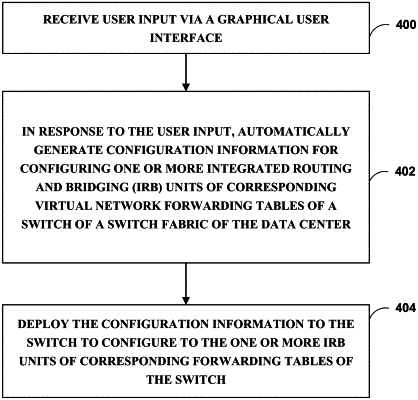| CPC H04L 45/42 (2013.01) [H04L 41/22 (2013.01); H04L 45/586 (2013.01); H04L 67/1014 (2013.01)] | 20 Claims |

|
1. A method comprising:
receiving, by a virtual network controller device of a data center network, a user input via a graphical user interface (GUI),
wherein the user input specifies one or more of:
a routing protocol session,
a bidirectional forwarding detection (BFD) session,
a static route setting,
an external Border Gateway Protocol (eBGP) enablement status, or
BFD support;
automatically generating, by the virtual network controller device of the data center network, for one or more integrated routing and bridging (IRB) units of corresponding virtual network forwarding tables of a switch of a switch fabric of the data center, configuration information based on the user input,
wherein the automatically generated configuration information, when deployed, causes the IRB units to direct data traffic conforming to multiple communication protocols and flowing over a plurality of virtual networks between a first set of server devices and a second set of server devices positioned outside of the switch fabric (i) toward a service device logically positioned outside of the switch fabric and coupled to the switch, and (ii) back from the service device into the switch fabric via the switch, and
wherein the IRB units are configured to be agnostic when steering traffic to the service device; and
deploying, by the virtual network controller device, the automatically generated configuration information to configure the one or more IRB units of the corresponding forwarding tables of the switch according to the automatically generated configuration information.
|